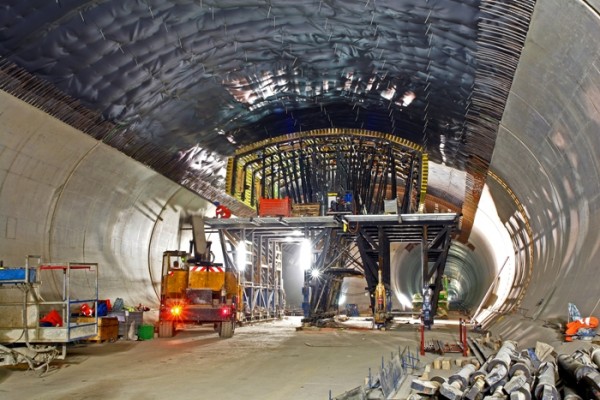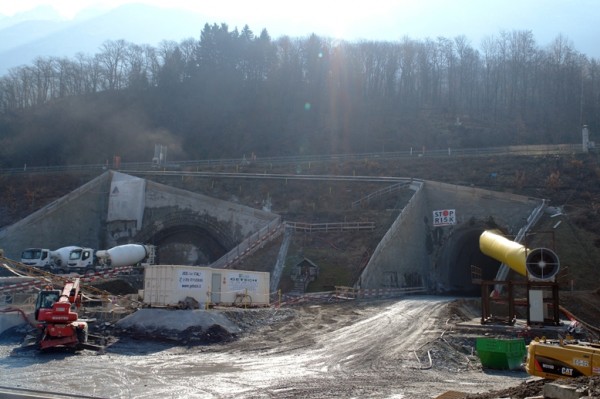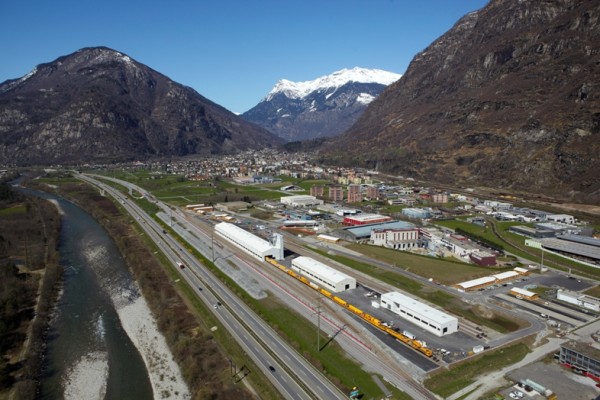Gotthard and Ceneri take major steps forward
Posted: 4 August 2010 | | No comments yet
Construction of the new Gotthard line with the Gotthard and Ceneri Base Tunnels is on course. In October 2010, a further milestone will be the final breakthrough of the Gotthard: the miners will excavate the last stretch of rock between the portals at Erstfeld and Bodio/Pollegio. On the Ceneri, in March 2010, driving towards the north and south began from the intermediate heading at Sigirino. Both construction projects have therefore taken a major step forward towards their respective scheduled openings in 2017 (Gotthard) and 2019 (Ceneri).
Construction of the new Gotthard line with the Gotthard and Ceneri Base Tunnels is on course. In October 2010, a further milestone will be the final breakthrough of the Gotthard: the miners will excavate the last stretch of rock between the portals at Erstfeld and Bodio/Pollegio. On the Ceneri, in March 2010, driving towards the north and south began from the intermediate heading at Sigirino. Both construction projects have therefore taken a major step forward towards their respective scheduled openings in 2017 (Gotthard) and 2019 (Ceneri).
Construction of the new Gotthard line with the Gotthard and Ceneri Base Tunnels is on course. In October 2010, a further milestone will be the final breakthrough of the Gotthard: the miners will excavate the last stretch of rock between the portals at Erstfeld and Bodio/Pollegio. On the Ceneri, in March 2010, driving towards the north and south began from the intermediate heading at Sigirino. Both construction projects have therefore taken a major step forward towards their respective scheduled openings in 2017 (Gotthard) and 2019 (Ceneri).
Gotthard
At the time of writing this article, more than 95% of the 57km-long Gotthard Base Tunnel has been excavated. The final breakthrough between the Faido and Sedrun sections is expected to take place in the east tunnel on 15 October 2010. Until then, the tunnel boring machine in the east tunnel has only slightly less than 1,500 metres of rock ahead of it.
Status of work on the Gotthard
The main work that was performed in the various sections of the Gotthard Base Tunnel since summer 2009 is as follows:
The overground approach section north (Altdorf–Rynächt)
Work on the railway trackbed and the various building constructions such as underpasses and bridges continued. For these various constructions along the SFR main line, temporary diversions of roads and railway tracks were necessary. The construction of the railway infrastructure installations site at Erstfeld is complete and ready for the temporary buildings of the railway infrastructure consortium. The railway infrastructure building in front of the north portal is under construction.


Installation of the vault framework in the Tunnel Crossover Expansion Chamber 1 at Sedrun
The Erstfeld section
On June 16, 2009, Tunnel Boring Machine Gabi 1 broke through the last metres of rock in the east tunnel between Erstfeld and Amsteg. By covering a distance of 7.2km in only 18 months, the machine reached Amsteg half a year earlier than planned. Three months later, on 16 September 16, breakthrough also took place in the west tunnel. Work on the cut-and-cover tunnel, which in the future will form the most northerly section of the Gotthard Base Tunnel, is also progressing rapidly. At this present time, of the 600m of cut-and-cover tunnel, concreting is complete on 440m of the east tunnel and 340m of the west tunnel.
The Amsteg section
During the course of 2009, the inner lining of the Amsteg–Sedrun section was completed. Installation of the construction shell infrastructure systems in the cross galleries, comprising doors, cross-gallery ventilation and technical floors, was also completed. Since December 2009, this section has been ready for installation of the railway infrastructure systems.
The Sedrun section
Driving to the south by drilling and blasting attained good daily advance rates of 6 to 7 metres in both tunnels. The inner lining of the Sedrun multifunction station continued and the main work comprised of concreting the air-extraction shafts and further work on the tunnel crossover expansion chambers.
The Faido section
The inner lining of the Faido multifunction station continued, concentrating on airextraction shafts and air-extraction shaft-top caverns. At the beginning of 2009, the tunnel boring machine in the west tunnel followed the tunnel boring machine in the east tunnel by crossing the once-feared Piora syncline. In September 2009, the boundary between the cantons of Ticino and Grisons was crossed. The final breakthrough between the Faido and the Sedrun sections is scheduled to take place in the east tunnel on 15 October 2010.
In March 2010, the tunnel boring machine in the west tunnel of the Faido section encountered an interference zone and had to suspend driving until presumably July 2010. Exploratory and support measures were initiated. The area of the rockfall was reinforced with injection drillings from the parallelrunning east tunnel. The few months interruption in driving will have no effect on the time schedule or commissioning of the Gotthard Base Tunnel at the end of 2017. However, the rockfall once again makes clear that in tunnel construction, geological surprises can never be ruled out.
The Bodio section
In May 2010 in the west tunnel between Bodio and Faido, installation of the railway infrastructure began. The east tunnel will continue to be used for supplies to the tunnel construction sites at Faido.


Driving work in the area of the portal at Vigana is taking place only slightly below the motorway
The overground approach line south
At the end of 2009, the groundbreaking ceremony took place for the new Operations Control Centre of Swiss Federal Railways at Pollegio. In the future, all railway traffic between Arth-Goldau and Chiasso will be controlled from here.
Installation of the railway infrastructure in the Gotthard Base Tunnel has begun
In the three sections Amsteg, Sedrun North, and Bodio West, the single-track tunnels have been fully concreted along a length of more than 40km and are ready for installation of the railway infrastructure. Installation of the railway infrastructure in the Gotthard Base Tunnel will start in June 2010, proceeding in a northerly direction from the south portal. It will therefore take place in parallel with completion of the works on the tunnel shell in the other sections of the tunnel.
The first section to have the railway infrastructure installed will be the west tunnel between Faido and Bodio. In this 14km-long section, as from 2011 test runs at speeds of up to 200kp/h will be performed. All railway infrastructure systems will be tested for their interaction and functionality.
Railway infrastructure surface installations site south
In the last few months, important preparatory work was carried out for installation of the railway infrastructure in the Gotthard Base Tunnel. For instance at Biasca, the approximately 70,000m2 surface installations site south was set up at a location 7km south of the future portal at Bodio. Assembly halls, workshops, and an on-site concrete plant, as well as offices and accommodation for up to 700 employees, have been constructed. This overground installations site will form the logistical basis for installation of the railway infrastructure systems in the Gotthard Base Tunnel. From 2011, a surface installations site will also be put into operation near the north portal at Erstfeld. The main installation of the railway systems will take place there from 2013.
Permanent and temporary systems
The railway infrastructure comprises, on the one hand, permanent systems such as the concreted trackbed, the catenaries, the electric power supply, the 16.7 Hz tractive power supply, and telecommunications installations for landline, wireless and safety systems. On the other hand, for the duration of construction, temporary systems such as construction plant power supply, construction telecommunications and construction site ventilation are required. These systems will be installed first. The entire railway infrastructure work in the Gotthard Base Tunnel will be carried out by Transtec Gotthard AG. This consortium was awarded the contract with a value of CHF 1.7 billion Swiss francs by the tunnel owner, AlpTransit Gotthard Ltd.


Aerial view of Biasca surface installations site
Railway infrastructure installation presents logistical challenges
The greatest challenges for installation of the railway systems are the tight space conditions in the tunnel. All of the material must be brought into the tunnel through the two portals and entirely by rail. Access for tyred vehicles, and particularly turning space in the tunnel, are very limited. More than 1,000 technical interfaces must be coordinated to make smooth rail traffic in the Gotthard Base Tunnel possible. The material required includes 31,000m3 of concrete for the trackbed, 308km of rail, 3,200km of copper cable for the power supply, 417 emergency-call columns, and 120km of antenna cable for wireless communication.
Ceneri Base Tunnel
Of the total of 39.78km of tunnels, shafts and passages of the 15.4km-long Ceneri Base Tunnel, just under 20% have been excavated to date. Only with the Ceneri Base Tunnel as southward continuation of the Gotthard Base Tunnel will a continuous flat route through the Swiss Alps be created. Driving is in progress on all three construction sites of the Ceneri Base Tunnel: on the two portal approaches at Vigana in the north and Vezia in the south, as well as on the intermediate heading at Sigirino. The Ceneri Base Tunnel is being driven entirely by conventional means with drilling and blasting.
Status of work on the Ceneri
The following work has been carried out on the various sections of the Ceneri Base Tunnel since summer 2009:
North portal: Camorino/Vigana
At Camorino, in the area to the north of the north portal, work was performed on various building constructions and sub-projects. For example, channels and underpasses were constructed. In the future, these will allow construction of the railway approach lines to the north portal of the Ceneri. Two new bridges are also being constructed: the new Swiss Federal Railways Morobbia bridge near Giubiasco station and the bridge over the A2 motorway.
Driving work in the area of the north portal at Vigana already began in 2009. Because of the close vertical distance to the overlying A2 motorway, the work must be carried out with special caution. At the west portal (the future Lugano–Bellinzona ‘bretella’) the A2 motorway was already crossed under at the beginning of 2010. At the east portal (dual-track portal for the Bellinzona–Lugano and Locarno–Lugano links) driving work is already in progress.


Erstfeld surface installations site with the two cut-and-cover tunnels
Sigirino intermediate heading
In October 2009, the work contract for the main construction work on the Ceneri Base Tunnel was signed. The work comprises driving the two single-track tunnels northwards and southwards from the Sigirino intermediate heading and has a value of one billion Swiss francs.
The first blast at the Sigirino intermediate heading for the main drive northwards and southwards took place in March 2010. The driving work will last until 2015.
South portal: Vezia
In the last few months, various preparatory works for driving were also carried out at the south portal. For instance, the excavation work in the area of the portal was completed and the work for adaptation of the SFR main line south of the future south portal was started.
At the beginning of April 2010, with the first blast at Vezia, driving of the first 300m of tunnel northwards began. Also at the south portal, because of the close proximity to residential and constructional infrastructures, including the late seventeenth-century Villa Negroni, the driving work must be executed with special care.
NRLA – Major Swiss Railway Infrastructure Project
The two base tunnels under the Gotthard and Ceneri are part of the New Rail Link through the Alps (NRLA) which will create a flat railway route through the Swiss Alps. The new railway line with two single-track tunnels has a maximum gradient of two per thousand in the base tunnels. The highest point of the tunnel is at 550m above sea level. The Gotthard axis of the NRLA will promote the transfer of transalpine goods traffic onto the railways and reduce the train journey time for passengers travelling between Zurich and Milan to less than three hours. www.alptransit.ch
About the Author
Renzo Simoni
Renzo Simoni has been working at AlpTransit Gotthard Ltd since 1 April 2007. His past employment includes working for Helbling Beratung + Bauplanung AG, Ernst Basel + Partner AG and Gruner AG. Mr. Simoni studied civil engineering at ETH Zurich and also took a Postgraduate Diploma in Spatial Planning, plus writing a Doctoral Thesis at the ORL Institute.








